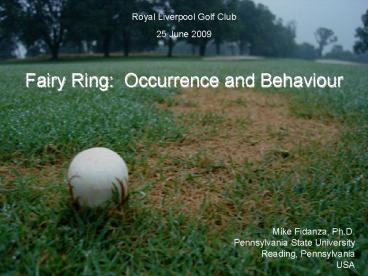Pennsylvania State University - PowerPoint PPT Presentation
1 / 54
Title:
Pennsylvania State University
Description:
Fairy Ring: Occurrence and Behaviour. Royal Liverpool Golf Club ... colonize soil (edaphic) colonize thatch (lectophilic) turfgrass. thatch. soil (rootzone) ... – PowerPoint PPT presentation
Number of Views:64
Avg rating:3.0/5.0
Title: Pennsylvania State University
1
(No Transcript)
2
Pennsylvania State University
3
(No Transcript)
4
(No Transcript)
5
(No Transcript)
6
Fisher and Donaldson Bakery, St. Andrews
7
(No Transcript)
8
The Open 2000 Old Course at St. Andrews
9
The Open 2000 Old Course at St. Andrews
10
The Open 2000 Old Course at St. Andrews
11
Courtesy of Steve Isaac
12
Fairy Ring occurrence and behaviour of fairy
ring in turfgrass ecosystems causes and
where/when/why? effects on turfgrass and
symptoms (fairy ring types) fairy ring
species
13
What organism causes fairy ring?
14
What organism causes fairy ring? basidiomycete
mushroom fungi.
15
(No Transcript)
16
The Humongous Fungus
Nature (1992, 356428-431) Northern Michigan,
USA 90 ha 9500 kg 1,500 years old
decomposition of oak (Quercus sp.) trees
17
(No Transcript)
18
(No Transcript)
19
Fairy ring where, when, why?
greens fairways tees roughs everywhere spri
ng summer autumn fall anytime
20
(No Transcript)
21
(No Transcript)
22
(No Transcript)
23
(No Transcript)
24
How does fairy ring affect turf?
- the fungal mycelium in the soil will coat sand
and soil particles (particles become hydrophobic
or water-repellent) - colonized area can become severely hydrophobic
- soil is difficult to re-wet
- decomposition or organic matter and thatch
- release of toxic compounds in the soil rootzone
- depletion of available N
- loss of turf due to drought and other factors
25
Rhizoctonia blight (Rhizoctonia solani)
26
Decomposition of organic matter.
27
Fairy Ring Symptoms
- rings or arcs
- dead or unhealthy turf
- dark green and stimulated turf
- - decomposition of organic matter and release
of ammonium-N (NH4) - - NH4 is processed by soil microorganisms into
nitrates - - nitrates contribute to green and growing turf
- - turf can react similar to a high dose of
nitrate fertilizer - mushrooms
- drought or water-stress indications
- - hydrophobic or water-repellent areas
- - localized dry spots
28
Fairy Ring Symptoms
- three types
- based on visual symptoms as expressed in turf
- Type I. - turf killed or severe injury
- Type II. - turf stimulated (dark green rings or
arcs) - Type III. - mushrooms present (no turf damage or
stimulation)
29
Examples of type I symptoms
Courtesy of Tom Malehorn
30
(No Transcript)
31
(No Transcript)
32
(No Transcript)
33
Examples of type II symptoms
34
(No Transcript)
35
(No Transcript)
36
(No Transcript)
37
Fairy Ring?
38
Champ
39
Examples of type III symptoms
40
Fairy Ring Species 60 basidiomycete species
attributed fairy ring in turf
Couch, 1995
41
Examples of Fairy Ring Species based on
basidiocarp identification
Marasmius oreades (fairy ring mushroom)
42
Lepiota sp. appearing in lawn a few days after a
rain event.
43
Lepiota procera parasol mushroom.
44
Coprinus sp. common in mulch beds. Some Coprinus
sp. are common in cool-season turfgrass fairways
(Northern USA climate) and bermudagrass (Cynodon
sp.) greens (Southern USA climate).
45
Amanita virosa Destroying Angel
these specimens found growing in a lawn below a
beech tree (Fagus sylvatica).
46
Agaricus campestris (meadow mushroom)
47
Coprinus comatus (shaggy mane)
48
Agaricus sp. in sports pitch (Festuca
arundinaceae).
49
Chlorophyllum sp.
50
Unidentified.
51
(No Transcript)
52
(No Transcript)
53
Summary basidiomycete fungi ( 60species
) indirect, negative effect on turfgrass type
I, II, and III symptoms soil hydrophobicity
wet/dry environmental conditions impact
turf surface playability/performance
54
Thank You!
Fairy Ring Occurrence and Behaviour
Mike Fidanza, Ph.D. fidanza_at_psu.edu
John Kaminski, Ph.D., Pennsylvania State
University, University Park, PA. Mike Fidanza,
Ph.D., Pennsylvania State University, Reading, PA.

